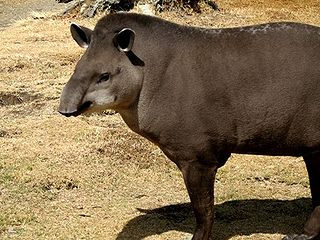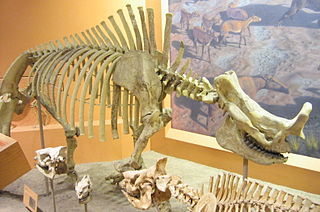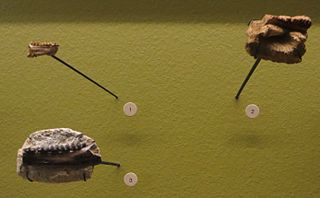
Equidae is the taxonomic family of horses and related animals, including the extant horses, asses, and zebras, and many other species known only from fossils. The family evolved around 50 million years ago from a small, multi-toed ungulate into larger, single-toed animals. All extant species are in the genus Equus, which originated in North America. Equidae belongs to the order Perissodactyla, which includes the extant tapirs and rhinoceros, and several extinct families. It is more specifically grouped within the superfamily Equoidea, the only other family being the extinct Palaeotheriidae.

Perissodactyla is an order of ungulates. The order includes about 17 living species divided into three families: Equidae, Rhinocerotidae (rhinoceroses), and Tapiridae (tapirs). They typically have reduced the weight-bearing toes to three or one of the five original toes, though tapirs retain four toes on their front feet. The nonweight-bearing toes are either present, absent, vestigial, or positioned posteriorly. By contrast, artiodactyls bear most of their weight equally on four or two of the five toes: their third and fourth toes. Another difference between the two is that perissodactyls digest plant cellulose in their intestines, rather than in one or more stomach chambers as artiodactyls, with the exception of Suina, do.

Amphicyonidae is an extinct family of terrestrial carnivorans belonging to the suborder Caniformia. They first appeared in North America in the middle Eocene, spread to Europe by the late Eocene, and further spread to Asia and Africa by the early Miocene. They had largely disappeared worldwide by the late Miocene, with the latest recorded species at the end of the Miocene in Africa. They were among the first carnivorans to evolve large body size. Amphicyonids are colloquially referred to as "bear-dogs".

Propalaeotherium was an early genus of perissodactyl endemic to Europe and Asia during the early Eocene. There are currently six recognised species within the genus, with P. isselanum as the type species.

Palaeotherium is an extinct genus of equoid that lived in Europe and possibly the Middle East from the Middle Eocene to the Early Oligocene. It is the type genus of the Palaeotheriidae, a group exclusive to the Palaeogene that was closest in relation to the Equidae, which contains horses plus their closest relatives and ancestors. Fossils of Palaeotherium were first described in 1782 by the French naturalist Robert de Lamanon and then closely studied by another French naturalist, Georges Cuvier, after 1798. Cuvier erected the genus in 1804 and recognized multiple species based on overall fossil sizes and forms. As one of the first fossil genera to be recognized with official taxonomic authority, it is recognized as an important milestone within the field of palaeontology. The research by early naturalists on Palaeotherium contributed to the developing ideas of evolution, extinction, and succession and demonstrating the morphological diversity of different species within one genus.

Palaeotheriidae is an extinct family of herbivorous perissodactyl mammals that inhabited Europe, with less abundant remains also known from Asia, from the mid-Eocene to the early Oligocene. They are classified in Equoidea, along with the living family Equidae.

Tapiroidea is a superfamily of perissodactyls which includes the modern tapirs and their extinct relatives. Taxonomically, they are placed in suborder Ceratomorpha along with the rhino superfamily, Rhinocerotoidea.The first members of Tapiroidea appeared during the Early Eocene, 55 million years ago, and were present in North America and Asia during the Eocene. Tapiridae first appeared during the early Oligocene in Europe, and are thought to have originated from the tapiroid family Helaletidae.

Pterodon is an extinct genus of hyaenodont in the family Hyainailouridae, containing five species. The type species Pterodon dasyuroides is known exclusively from the late Eocene to the earliest Oligocene of western Europe. The genus was first erected by the French zoologist Henri Marie Ducrotay de Blainville in 1839, who said that Georges Cuvier presented one of its fossils to a conference in 1828 but died before he could make a formal description of it. It was the second hyaenodont genus with taxonomic validity after Hyaenodon, but this resulted in taxonomic confusion over the validities of the two genera by other taxonomists. Although the taxonomic status of Pterodon was revised during the late 19th and early 20th centuries, it became a wastebasket taxon for other hyaenodont species found in Africa and Asia. Today, only the type species is recognized as belonging to the genus while four others are pending reassessment to other genera.
Duerotherium is an extinct genus of Palaeogene artiodactyls known only from the Iberian Peninsula during the Middle Eocene, which contains one species D. sudrei. It, like other members of the Anoplotheriidae, was endemic to Western Europe. The anoplotheriine was described from a left fragment of a maxilla from the Mazaterón Formation of the Duero Basin in 2009. Its dentition is mostly typical of the Anoplotheriinae but differs by an elongated plus triangular 3rd upper premolar and very specific traits of the molars. It is thought to have been part of an endemic faunal assemblage that evolved within the Iberian Peninsula by the Middle Eocene, where climates were subtropical.

Brontotheriidae is a family of extinct mammals belonging to the order Perissodactyla, the order that includes horses, rhinoceroses, and tapirs. Superficially, they looked rather like rhinos with some developing bony nose horns, and were some of the earliest mammals to have evolved large body sizes of several tonnes. They lived around 56–34 million years ago, until the very close of the Eocene. Brontotheres had a Holarctic distribution, with the exception of Western Europe: they occupied North America, Asia, and Eastern Europe. They were the first fossilized mammals to be discovered west of the Mississippi, and were first discovered in South Dakota.

Plagiolophus is an extinct genus of equoids belonging to the family Palaeotheriidae. It lived in Europe from the middle Oligocene to the early Oligocene. The type species P. minor was initially described by the French naturalist Georges Cuvier in 1804 based on postcranial material including a now-lost skeleton originally from the Paris Basin. It was classified to Palaeotherium the same year but was reclassified to the subgenus Plagiolophus, named by Auguste Pomel in 1847. Plagiolophus was promoted to genus rank by subsequent palaeontologists and today includes as many as seventeen species. As proposed by the French palaeontologist Jean A. Remy in 2004, it is defined by three subgenera: Plagiolophus, Paloplotherium, and Fraasiolophus.

Altungulata or Pantomesaxonia is an invalid clade (mirorder) of ungulate mammals comprising the perissodactyls, hyracoids, and tethytheres.
This paleomammalogy list records new fossil mammal taxa that were described during the year 2013, as well as notes other significant paleomammalogy discoveries and events which occurred during that year.
Cambaytherium is an extinct genus of placental mammals in the family Cambaytheriidae whose fossils were found in an open pit coal mine located in Gujarat, India. The mine was a treasure trove full of teeth and bones, over 200 of which were identified as belonging to Cambaytherium thewissi. The fossils were dated to the Early Eocene, 54.5 million years ago, making them slightly younger than the oldest known fossils belonging to the order Perissodactyla.

Systemodon is a genus of early Eocene mammal of Wasatchian age. It was one of many mammals originally considered the earliest horses, long classified in the genus Hyracotherium. These were dog-sized animals that in life would have looked vaguely like a paca, mara, or chevrotain The type species, S. tapirinus, is represented by 24 individuals from a locale called the Castillo pocket in the Huerfano Formation of Colorado. This well-preserved deposit allows researchers to reconstruct aspects of the environment and lifestyle of the species.

Dichodon is an extinct genus of Palaeogene artiodactyls belonging to the family Xiphodontidae. It was endemic to Western Europe and lived from the middle Eocene up to the earliest Oligocene. The genus was first erected by the British naturalist Richard Owen in 1848 based on dental remains from the fossil beds in Hordle, England. He noticed similar dentitions to contemporary artiodactyls like those of the Anoplotheriidae and Dichobunidae and references the name of the genus Dichobune. Eventually, it was found to be more closely related to Xiphodon and now includes 11 species, although one of them may be synonymous.
Robiatherium is an extinct genus of Palaeogene artiodactyls containing one species R. cournovense. The genus name derives from the locality of Robiac in France where some of its fossil were described plus the Greek θήρ/therium meaning "beast" or "wild animal". It was known only from the middle Eocene and, like other anoplotheriids, was endemic to Western Europe. The genus was erected by Jean Sudre in 1988 for a species originally attributed to the xiphodont genus Paraxiphodon in 1978. Robiatherium had dentitions typical of the subfamily Anoplotheriinae, differing from other genera by specific differences in the molars. It is one of the earliest-appearing anoplotheriine species in the fossil record as well as the earliest to have appeared in Central Europe.

Mixtotherium is an extinct genus of Palaeogene artiodactyls belonging to the monotypic family Mixtotheriidae. Known informally as mixtotheriids or mixtotheres, these artiodactyls were endemic to western Europe and occurred from the middle to late Eocene. The genus and type species were both first established by the French naturalist Henri Filhol in 1880. Several species are well known by good skull fossils, which were informative enough to allow for classifications of the species to their own family. The Mixtotheriidae, first recognized by Helga Sharpe Pearson in 1927, is currently known by 7 valid species, although M. priscum is thought by several authors to be synonymous with M. gresslyi. The affinities of the Mixtotheriidae in relation to other artiodactyl families is uncertain, but it is currently thought to have been related to the Cainotherioidea and Anoplotheriidae.
Haplomeryx is an extinct genus of Palaeogene artiodactyls belonging to the family Xiphodontidae. It was endemic to Western Europe and lived from the middle Eocene up to the earliest Oligocene. Haplomeryx was first established as a genus by the German naturalist Max Schlosser in 1886 based on a molar tooth set from Quercy Phosphorites deposits. Three additional species were erected and classified to the xiphodontid genus while one other species, first recognized in 1822, was tentatively classified to it and remains unresolved in affinity.

The anatomy of Palaeotherium has been historically well-studied due to at least several of its species being known from common and good fossil material. As the type genus of the Palaeotheriidae, one of two families within the Equoidea, it shares common traits such as orbits that are wide in its back plus located in the skull's midlength, long nasal bones, selenodont form molars, and the presence of diastemata between the canine and other teeth between it. Palaeotherium itself differs from other palaeotheres primarily based on various cranial and dental traits; the subgenus Palaeotherium is likewise distinguished from the other subgenus Franzenitherium based on specialized and specific cranial traits. While not as often studied, Palaeotherium is also known by viable limb bone material, leading to the locomotion of different species being hypothesized. P. magnum, unlike other species, is known by complete skeletal material such as that from Mormoiron in France that is informative about its overall anatomy, sharing similar and different traits from equines and other perissodactyls.

























